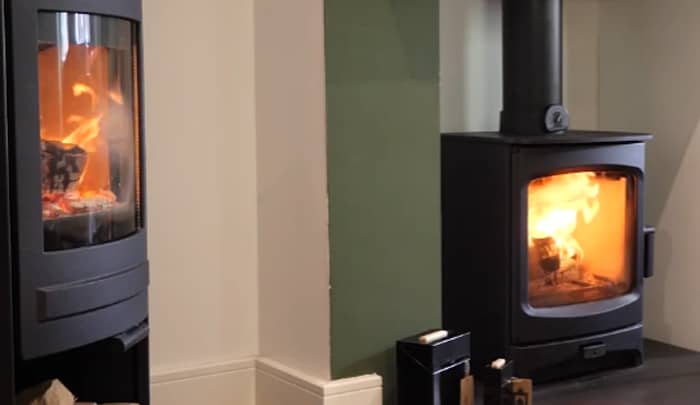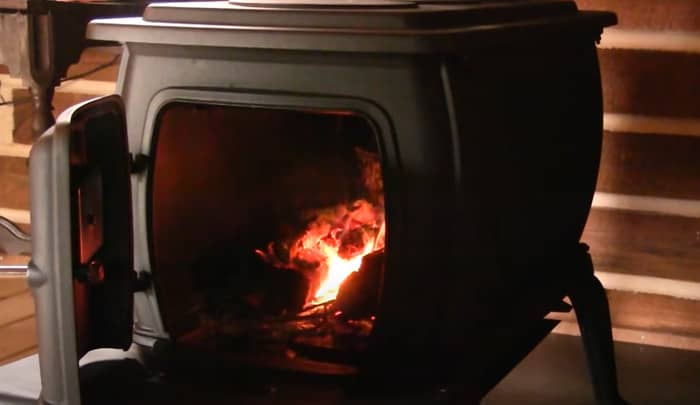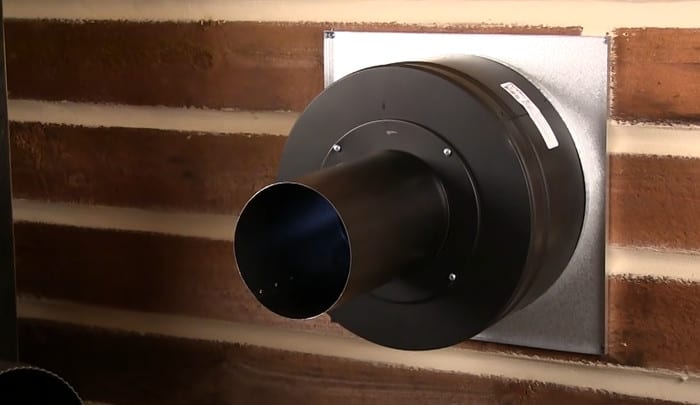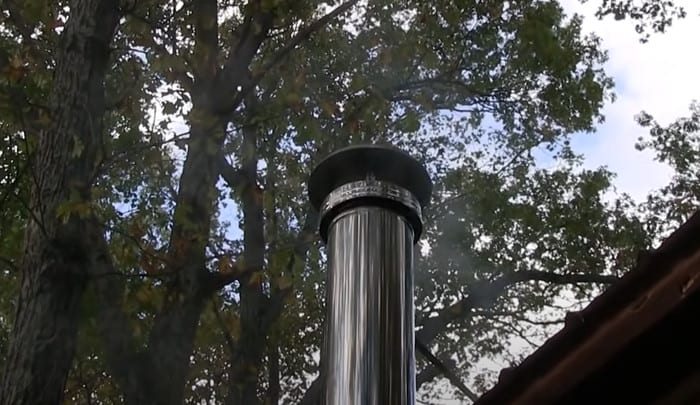At first thought, log burners without chimneys would seem an impossible concept: How can you properly and safely contain and vent the smoke created from burning logs without a chimney? Many homeowners are considering alternatives to wood burners for this very reason? But, thanks to recent advances in technology, you’d be surprised to hear that log burners without chimneys do exist. In this guide, we’ll explain how you can safely and effectively use log burners in your home or on the go, without the need for a chimney or the associated permit requirements. We’ll discuss the advantages and disadvantages of log burners without chimneys, including the types of technology used to contain the smoke, and the unique safety considerations that come with it. We’ll also go over a few tips to ensure a safe use of log burners without chimneys, and give you an overview of the steps you should take when purchasing one. So, let’s get started and explore the world of log burners without chimneys.
One option is to use a jack and pump system to push up the floor in smaller increments. You may also want to consider lowering the grade of the exterior foundation walls, or adding a sub-basement room below your existing basement level.
“It’s crucial to understand that log burners, even without chimneys, can be completely safe if used correctly. Air quality, vent positioning, and appropriate fuel are factors that determine their effectiveness and safety. However, professional guidance and installation are always recommended for the best results.”
Jerome Cassidy, Fire Safety Engineer
What is a Chimneyless Log Burner?
A chimneyless log burner is a heating appliance that eliminates the need for an external chimney. Instead, these devices, similar to electric fireplaces, use built-in fans to filter out smoke and gases through their exhaust port. Despite the lack of a standard chimney, many of these units can still ventilate the room by sending heat up and away from the home. The result is efficient heating without the need for costly installations or smoke venting.

The debate raging around these log burners centers around safety. On one hand, proponents point to their convenience and ability to be used in almost any room; however, on the other side opponents claim that they are not as safe as a traditional fireplace because they generate more carbon monoxide. Additionally, there are worries that these direct-vent models, while able to ventilate the room and area near the firebox, do not move both heat and smoke away fast enough – posing a potential safety risk if not used correctly.
Ultimately, it all comes down to proper installation and usage. Users should always follow all safety regulations pertaining to their particular heater and take all necessary precautions as outlined in device manuals when using them. With this in mind, chimneyless log burners can be safely used without issues – provided they are installed correctly and following all guidelines.
Now that we understand what a chimneyless log burner is and the debate around their usage, let’s move on to looking deeper into why opting for such a product has many advantages over conventional fireplaces—the focus of our next section on: “Benefits of a Chimneyless Log Burner”!
Benefits of a Chimneyless Log Burner
A chimneyless log burner can offer a lot of benefits to homeowners. Many homeowners are drawn to the ease and convenience of burning logs without needing a chimney, as well as the cost savings that come along with this type of heating. Here we will examine some of the major advantages of using a chimneyless log burner, as well as some of the drawbacks that should also be taken into consideration.
The most obvious benefit of using a chimneyless log burner is that it eliminates the need for an expensive and intrusive chimney construction project in your home. Without having to build a chimney, you save significant amounts on the construction work, materials, and labour costs associated with traditional wood-burning stoves. Chimneyless log burners do not require any outside venting or complex installation processes, thereby reducing their total cost even more.
Another advantage to these stoves is that they tend to be more efficient than conventional wood-burning stoves. This is because they generate almost no smoke, meaning that less heat escapes through the chimney which results in greater efficiency. In addition, they also produce less ash which makes them easier to clean and maintain over time.
In terms of drawbacks however, there are a few things to consider before investing in a chimneyless log burner. For one thing, chimneyless log burners generate a lot of carbon dioxide which needs to be accounted for with proper ventilation in place inside the home. Without allowing enough air circulation or using fans to dissipate the gases generated by the fire, your home may become increasingly polluted and unhealthy for you and your family. Additionally, some communities have restrictions on using non-vented appliances as they may cause excess emissions from entering public areas.
Overall then, chimneyless log burners provide many attractive benefits such as low installation and maintenance costs as well as improved efficiency over conventional wood-burning stoves. However, it is important to consider potential issues associated with venting carbon dioxide into the living space before making any final decisions about installing one in your home. With this information in mind, the next section will examine several different types of available chimneyless log burners on the market today.
Types of Chimneyless Log Burners
Chimneyless log burners, sometimes also referred to as smokeless fireplaces, are becoming increasingly popular due to their convenience and versatility. They offer an efficient, secure way to enjoy the beauty and warmth of a flame without the need for a traditional chimney system. However, there are different types of chimneyless log burners which come with different features, so it’s important to understand what type is best suited to your needs before making a decision.
The two main types of chimneyless log burners are vented and unvented. Vented log burners require some additional installation as they require a vent pipe that runs outside the property in order for them to be safe and for them to work efficiently. On the contrary, unvented log burners have no external venting system required, which makes them simpler and easier to install.
Proponents of vented log burners say that although they take more time and effort to install the amount of heat produced from these units is much greater than those from unvented log burners. This makes them ideal for larger spaces or homes with high ceilings or non-insulated walls as the increased heat output will keep the dwelling warm for longer periods of time than with an unvented unit. Additionally, vented log burners can be used in smaller rooms as well as drafty rooms that require more airflow to be effectively heated.

On the other hand, unvented fireplaces are often the preferred option amongst homeowners who want the convenience and ease of installation that they offer. These models often feature large glass doors and typically come fitted with fans to help move hot air around a room at an even temperature. They also produce less smoke and fewer pollutants than vented units so they can be a much better option if you’re concerned about air quality around your home.
Despite their advantages, both types of chimneyless log burners can be significantly more efficient on gas consumption compared to traditional open fires. Therefore, when done properly both provide excellent heating options without the need for a chimney.
In conclusion, deciding which type of chimneyless log burner is best suited for your needs will depend largely on your budget, home size and desired look as well as environmental concerns about air quality. With this guide you will now have a better understanding of both vented and unvented models so that you can make an informed decision when selecting one for your home.
Now let’s move onto discussing vented and unvented log burners in further detail in the following section…
Vented and Unvented Log Burners
Vented and unvented log burners are two distinct types of log burning appliances. Vented log burners, also known as ‘room sealed’ log burners, are by far the most common type being used today. This type of appliance is connected to an external flue systems, which ensures that all toxic gases and smoke from burning logs are channelled away from the inside of the home.
Unvented log burners on the other hand don’t require any connection to external flue systems. This type of appliance takes in air for combustion from around the appliance and expels the toxic gases back into the room it is located in. However, some of these unvented log burners still vent some gases up a chimney or outside wall via an internal flue system.
The debate amongst homeowners surrounding vented and unvented log burners mainly revolves around efficiency and cost-effectiveness. On one hand, vented log burners are more efficient as they channel all the smoke and dangerous emissions out of the house through an external pipe – which can be costly to install and maintain over time – whereas with unvented log burners some gases remain in the house making them slightly less efficient than their vented counterparts. But on the other hand, unvented log burners come with their own advantages such as being much cheaper to install, quicker to set up and easier to use as no pipes are required for installation.
So when considering installing a chimneyless log burner, it really comes down to personal preference and budget – choosing between efficiency vs cost effectiveness. Nevertheless, before taking a pick it’s important for homeowners to always consider all points involved before making a decision; consulting a professional or checking up on local regulations may be needed too before installation can commence.
The next section will examine how homeowners can go about installing a chimneyless log burner – taking into account the various factors that need to be considered during the installation process.

Top Takeaways
Vented and unvented log burners are two common types of log burning appliances. Vented log burners are connected to external flue systems and expel all toxic gases and smoke out of the house. Unvented log burners take in air for combustion from around the appliance, but some still vent gases up a chimney or outside wall. The debate surrounds efficiency and cost-effectiveness – vented log burners are more efficient, but unvented are cheaper to install. Before installation there should be consultation with a professional and local regulations need to be taken into account.
Installing a Chimneyless Log Burner
Installing a chimneyless log burner is an increasingly popular choice in modern homes, as they are easier to install and operate than conventional wood-burning stoves, while still providing enough heat to warm up a large room. Generally, the installation of a chimneyless log burner requires three steps: securing the unit in place, connecting it to a flue pipe and creating a safe, airtight seal around the fireplace or stove.
The first step when installing a chimneyless log burner is to find and secure the right location. Generally speaking, the location should be away from combustible materials like drywall or wood. In addition, there should be plenty of space around the appliance so as not to limit its efficiency. Once the location has been chosen, it is important to secure the unit in place with screws and securely affix any fasteners that may be needed for stability.
The second step involves attaching a flue pipe to the unit for safe exhaust venting. As these pipes can come in different sizes and varieties depending on the model of log burner being installed, it’s important to ensure that you select and properly fit the right type of venting system. Installing a quality fluepipe will help ensure that toxic gases are vented out of the room safely.
Finally, it is essential to create an airtight seal around the log burner to prevent deadly carbon monoxide from entering the house. To do this, you should employ caulk around all seams of the firebox and double-check for any potential leaks. Additionally, it’s important to purchase quality hearth boards that meet UL standards as well as other requisite regulatory requirements for an even safer installation.
Clearly, installing a chimneyless log burner requires careful planning and preparation for optimal efficiency and safety; however those willing to take on this project can enjoy all of the benefits of having a working stove without having to worry about complicated installations or costly repairs often associated with traditional wood-burning stoves. With that being said, let’s take a look at some of the pros and cons associated with using chimneyless log burners in your home.
- According to research conducted in 2018, out of all the homes in the United Kingdom without a chimney, an estimated 4.3 million are using alternative forms of heating such as electric fireplaces and pellet stoves.
- A 2019 survey found that approximately 28% of homes without a traditional chimney have opted for a direct-vent gas heater or stove as their primary source of heat for the home.
- The same 2019 survey also found that 14% of homes without a traditional chimney have opted for an indoor wood-burning appliance or outdoor wood furnace as their primary source of heat.
Pros and Cons of Chimneyless Log Burners
The decision to install a chimneyless log burner can be a difficult one. It comes with both benefits and drawbacks. Before making any decisions, it is important to understand the pros and cons of this heating option.
Pros:
One of the biggest advantages of a chimneyless log burner is that they are easier to install than traditional wood burning stoves. They do not require existing chimneys or flues, so they can be installed in almost any home. The costs associated with installation are often lower when compared to other heating options like fireplaces. In addition, using a log burner inside does not require you to build a fire outside like many other alternatives do.
Cons:
Chimneyless log burners do still require a vent system for safety reasons so that fumes from the burner do not remain in the home. This venting system must be installed by a knowledgeable and experienced technician since incorrect installation could lead to carbon monoxide entering your home which can be life-threatening. These systems may also come with higher operational costs due to the designed requirement that fan assisted log burners must be fitted with an electricity supply for power. Furthermore, litter elements such as ash and debris have nowhere to go in a chimneyless system, so regular cleaning is required in order to keep the burner functioning properly and safely.
It is important to thoroughly weigh all the pros and cons before making any decisions when it comes to installing a chimneyless log burner. Understanding the full capabilities and costs associated with this heating option is vital for ensuring optimal performance and efficiency as well as maximum safety. Now let us move on to explore what alternative heating options are available on the market today.

Alternative Heating Options
When considering alternative heating options, many people turn to log burners without chimneys as an effective, efficient and cost-saving way to heat their homes. While these systems are generally low maintenance, there are also other alternatives that should be considered depending on your particular needs and circumstances.
For those living in rural, off-grid areas, wood cooking stoves or fuel-fired stoves may be a viable option. Wood cooking stoves not only provide the necessary heat for the home but also can be used to cook food, making them a multi-functional appliance. Fuel-fired stoves are a more traditional choice for off-grid households, burning wood pellets or corn cobs in a combustible stove unit for even distribution of warmth. These general both require expert installation due to the complex nature of the combustion process and require regular maintenance.
Electricity is also an alternative heating source for those who have access to a reliable power grid. Electric furnaces offer efficient and cost-effective heating options with minimal maintenance needed over time. Many homeowners wonder, are electric fires expensive to run? The answer depends on various factors including usage and electricity rates. These systems range in efficiency and price, so it is best to research the various models available before committing to purchase. Electric wall and baseboard heaters are another popular choice, although they may be slightly less energy efficient compared to electric furnaces.
Propane furnaces are also available but require proper setup and installation by qualified technicians as they release carbon monoxide and other harmful gases into the air when used improperly. Furthermore, propane gas tanks need to be refilled on occasion which could incur additional costs throughout the season. Similarly, some people ask, are gas fires expensive to run? The cost can vary based on gas prices and usage patterns.
No matter which type of alternative heating system you choose, it’s important to weigh out all of the pros and cons before making a decision because each have their own benefits and drawbacks depending on your situation. At the end of the day, choosing what works best for you based on safety, cost efficiency and convenience should help make your decision easier.
Now that we’ve gone through some of the potential alternative heating options available, let’s move onto our conclusion in the following section which will wrap up our guide on log burners without chimneys.
Conclusion
Overall, log burners without chimneys are a great way to enjoy the warmth of a wood fire without the worry of having to maintain a traditional chimney. They offer a highly efficient and compact solution for heating purposes in households that do not have the space or budget for a traditional installation. Additionally, some models come equipped with ventilation systems that allow for enhanced air circulation.
On one hand, there are those who claim that using such burners in homes without chimneys is unsafe due to the lack of proper ventilation. On the other hand, proponents of log burners without chimneys point out that these products are specifically designed to be extremely safe and highly efficient, making them perfectly suitable for many homes and other establishments.
Ultimately, it is up to the user to decide if a log burner without chimney would be an appropriate choice for their home or establishment. While some may choose to go the traditional route, there are others who find that such solutions offer easy and cost-effective alternatives with all the benefits of a standard wood stove while also preventing any potential safety risks.
Answers to Commonly Asked Questions
What type of log burners are suitable for use without a chimney?
The best type of log burner for use without a chimney is one that has been specifically designed and approved for this purpose. These log burners often come with an integrated flue system, which means they can be installed with no chimney required, or in some cases, a short direct-vent pipe may be used. This type of log burner should have an efficiency rating of at least 80%, CE compliance certification and appropriate safety mechanisms, such as oxygen depletion sensors. Additionally, these log burners should be kept well maintained and regularly serviced by a qualified technician to ensure safe operation.
What safety precautions must be taken when using a log burner without a chimney?
When using a log burner without a chimney, it is important to take safety precautions to avoid the risk of fire or smoke inhalation. Firstly, ensure that the burner is placed on a stable surface away from any flammable objects or materials such as furniture, clothes, and curtains. Secondly, always use flames-resistant gloves when lighting and handling the logs. Thirdly, be sure that there is adequate ventilation in the room where the stove is located. This can be achieved by leaving a window open while the burner is in use or by installing an extraction fan if necessary. Finally, check the smoke detector regularly to ensure that it is working properly and replace its batteries when needed. Following these safety precautions will help reduce the risks associated with burning logs without a chimney.
What is the most efficient way to install a log burner without a chimney?
The most efficient way to install a log burner without a chimney is to utilize an existing flue or a purpose-built insulated twinwall pipe. When installing the burner, it is important to ensure that the walls of the flue are not exposed to high temperatures as this can cause both damage to the flue and create potential fire hazards. Additionally, proper installation includes ensuring the appropriate distance between any combustible surfaces and the burner, regular inspection and maintenance, and utilizing a carbon monoxide detector within the vicinity of the burner. Utilizing these precautions will ensure maximum efficiency and safety from a log burner without a chimney.
References
https://firewoodfund.co.uk/best-wood-burning-stoves/
https://www.thestoveyard.com/pages/what-is-the-best-wood-to-burn





I’ve used a ventless log burner in my cabin situated in the cozy Northwoods, and believe me, it’s been a real game-changer, sparing me the hassles of chimney maintenance.
Eckhart, I totally agree with you about the game-changing aspect of ventless log burners. When I eventually replaced my conventional one with a ventless model in my loft-style house, the decrease in maintenance time was significant!
Dimitri, you’re right on the money about the reduced maintenance time! In researching options for my own home, I’ve found ventless log burners incredibly versatile and practical. Just last month, we installed one in our living room, it’s made winters substantially more bearable. The fact that we didn’t have to also install a complex chimney system saved us a huge amount of time and effort in installation as well.
Absolutely Mabel, installing without a chimney can be a real game-changer. As an ex-firefighter, I’ve had my fair share of chimney fires and I can tell you, they’re not fun. This innovation in technology is really bringing security along with warmth to our homes.
“Designed and installed a log burner minus chimney in my off-grid studio, I can vouch that it not only added aesthetic appeal but also ensured cozy warmth in winter without polluting the environment.”
Kendrick, I agree wholeheartedly – the environmental benefits of these installations are noteworthy. Plus, they give an unmistakable character to any living space!